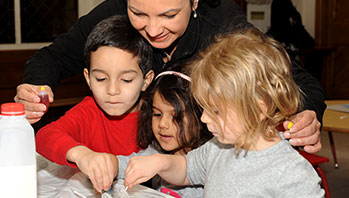- children’s ramps
- crayons
- drawing paper
- markers
- down
- faster
- move
- ramp
- roll
MA Standards:
English Language Arts/Language/L.PK.MA.6: Use words and phrases acquired through conversations, listening to books read aloud, activities, and play.
MA Draft Standards:
Physical Sciences/Motion and Stability; Forces and Interaction/PS2.A: Plan and carry out investigations of the behaviors of moving things.
Physical Sciences/Motion and Stability; Forces and Interaction/PS2.B: Using evidence, discuss ideas about what is making something move the way it does and how some movements can be controlled. [Cause and Effect, Stability and Change]
Head Start Outcomes:
Logic and Reasoning/Reasoning and Problem Solving: Recognizes cause and effect relationships.
Science Knowledge/Scientific Skills and Method: Uses senses and tools, including technology, to gather information, investigate materials, and observe processes and relationships.
Science Knowledge/Scientific Skills and Method: Collects, describes, and records information through discussions, drawings, maps, and charts.
PreK Learning Guidelines:
English Language Arts/Language 2: Participate actively in discussions, listen to the ideas of others, and ask and answer relevant questions.
Science and Technology/Inquiry Skills 4: Record observations and share ideas through simple forms of representation such as drawings.
Small Group: Ramp Races

© Commonwealth of Massachusetts, Department of Early Education and Care (Jennifer Waddell photographer). All rights reserved.
STEM Key Concepts: A ramp, or inclined plane, is a surface with one end higher than the other; An object placed on an inclined plane will roll, slide, or stay put; The shape of an object affects whether it will roll or slide or stay put
ELA Focus Skills: Speaking and Listening, Vocabulary
Have children continue to explore the ramp materials by racing objects down their ramps. Prompt them to make their ramps different heights, to race the same objects, to race different objects, etc. Ask questions such as,
- How do you think could you make the ball go faster down the ramp?
- Why do you think Ming’s car rolled further than Sean’s car rolled?
- What did you notice about Borgna’s ramp that was different from Helen’s ramp? What did you notice about how the ball moved down each ramp?
After groups have raced objects, explain that you want them to record their findings by drawing their constructions.
Educator Tip: Be sure to keep the focus of the activity on the objects and ramps and not on racing and competing. If it begins to get competitive, have children switch partners.
